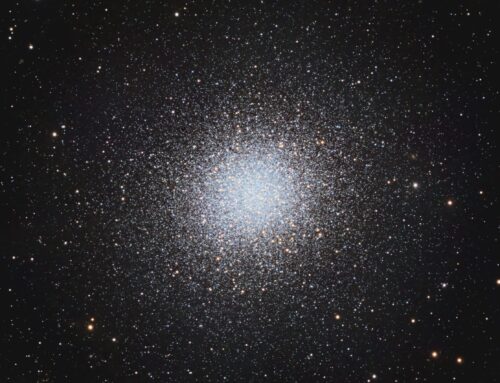Messier 5
 Click image for full size version
Click image for full size version
June 20, 2025
Messier 5 (M5) is a globular cluster. It lies about 25,000 light years away and is abouot 80 light years across. It’s just bright enough to see as a dim star with the naked eye in a dark sky. The cluster is notable for having at least 105 variable stars amongst its hundreds of thousands of luminaries.
M5 is one of my favourite objects to view in any scope. Bright globular clusters remind me of sugar spilled on a black table cloth. Although some globular clusters, like M5, are large, relatively bright, and easy to see in the eyepiece, they are challenging to image because the wide range of brightness from the centre to the halo.
Tekkies:
Acquisition, focusing, and control of Paramount MX mount with N.I.N.A., TheSkyX. Guiding with PHD2. Primalucelab low-profile 2″ Essato focuser and ARCO rotator. Equipment control with PrimaLuce Labs Eagle 4 Pro computer. All pre-processing and processing in PixInsight. Acquired from my SkyShed in Guelph. Data acquired under minimal moonlight, good transparency and average seeing June 1-2, 2025.
Celestron 14″ EDGE HD telescope at f/11 (3,940 mm focal length) and QHY600M camera binned 2×2 with Optolong filters.
17 x 5m Red = 85m
17 x 5m Green = 85m
16 x 5m Blue = 80m
Total: 4hr 10m
Preprocessing: The WeightedBatchPreProcessing script was used to perform calibration, cosmetic correction, weighting, registration, local normalization, and integration of all frames.
RGB master: An RGB image was made from the Red, Green and Blue masters using ChannelCombination in RGB mode.
Synthetic Luminance: A SynthL was made by integrating the three masters, weighted by SNR, with no pixel rejection.
Gradient Removal: DBE was used to remove gradients from the RGB and SynthL masters.
Colour Calibration: SpectrophotometricColorCalibration was used to calibrate the RGB master.
Deconvolution: BlurXterminator was applied to the RGB and SynthL masters with Automatic psf, star sharpening set to 0.35, and non-stellar set to 0.15.
Linear Noise Reduction: NoiseXterminator was applied to the RGB and SynthL masters with settings Amount=0.9 and Iterations=5
Stretching: HistogramTransformation was applied to the RGB and SynthL masters to make pleasing images. Approximate background level after stretch was 0.1 for SynthL and 0.09 for RGB.
Nonlinear Processing
Combinining SynthL and RGB: LRGBCombination was used to replace the lightness channel of the RGB image with the SynthL.
Nonlinear Noise Reduction: NoiseXterminator was used to reduce noise in the background areas of the SynthRGB master with Amount=0.9 and Detail=0.15.
Re-stretch: HistogramTransformation was used to boost contrast by moving the dark point to the toe of the histogram and slightly decreasing the mid-point slider.
Final Steps: Background, globular cluster, and star brightness, contrast, hue, and saturation were adjusted in several iterations using CurvesTransformation with masks as required. SCNR was applied (Average Neutral, full strengtH). CloneStamp was used to correct a couple of defects in the background (stars were temporarily removed with StarXterminator and replaced with PixelMath). ICCProfileTransformation (sRGB IEC61966-2.1; Relative Colorimetric with black point compensation) was applied prior to saving as a jpg. The finder chart was made using the FindingChart process.







Leave A Comment